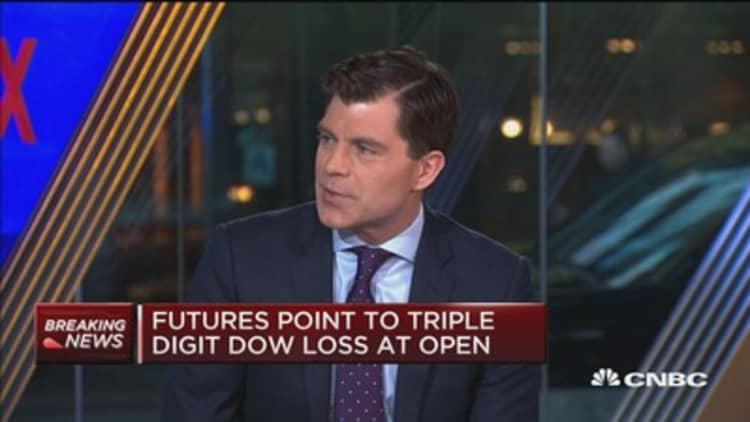
Tuesday was a wild one for investors, with markets dropping by hundreds of points only to rebound, fall some more and climb back up again. While the Dow Jones Industrial Average and the S&P 500 ended up in the black at the closing bell — they were up 2.3 percent and 1.7 percent, respectively — there's a good chance we'll see more swings in the days ahead.
There's not much that nervous investors can do to smooth out their returns in the immediate future, but start planning now for the next correction and you should be able to create a portfolio that stays relatively calm during the next big storm.
How can you avoid massive market swings? Here are five strategies to consider.
1. Go global
Every investor knows that diversification is key to a well-balanced portfolio, but that doesn't just mean putting money across the U.S. market. It's also important to invest outside of America — in international and emerging market securities, said Richard Weiss, chief investment officer of American Century Investments' multi-asset strategies.
While global markets fell alongside U.S. markets on Friday and Monday, international stocks aren't perfectly correlated to American stocks. In many cases when American equities fall, emerging market indexes, which are driven by different factors than U.S. stocks, have moved higher and vice versa.
In fact, according to website ETFreplay.com, since January 2007, the 60-day correlation between the SPDR S&P 500 Index ETF and the Vanguard FTSE Emerging Market Index has ranged from 0.34 to 0.97 — the lower the number, the less correlated the stocks.
"It may appear that equity markets around the world move in unison and that there's no diversification, but that's not true," said Weiss. "If you diversify across geographical lines, you do smooth out the volatility."

Don't just think globally with stocks, either. Many investors are buying emerging market bonds with higher yields or fixed income from markets, such as Europe, where monetary policy is still accommodative, he said.
2. Invest in alternatives
Over the last few years, alternative investments have become popular diversifiers. Many pension funds employ these kinds of investments, which encompass several different strategies, including hedge fund-like tactics and investments in hard real estate assets or private equity.
Many of these investments, and especially the more hedge fund-style strategies, don't move in line with stocks and bonds, said Weiss.
It's impossible to eliminate all volatility no matter how well the portfolio is constructed. You need to know your risk tolerance so at least you won't be surprised.Richard Weisschief investment officer, American Century Investments
"They exhibit low correlation and don't move at the same time," he said.
Craig Machel, director of wealth management for Toronto's Richardson GMP, is also a believer in hedge fund-like alternatives. He especially likes long-short, where a manager goes long on good companies with attractive valuations and short companies that are fraught with issues.
In a downturn, both will fall, but the good companies shouldn't fall as much as the bad ones, which means you end up making more on the shorts than you lose on the longs.
"It's not about shooting the lights out," says Machel about alternatives. "You're just trying to reduce risk."
3. Buy a VIX-tracking ETF
This may seem like the last recommendation to be making this week, a week during which volatility exchange-traded products are being blamed by many market participants for the stock plunge, or at least, for contributing in a major way to it.
But owning the CBOE Volatility Index, better known as the VIX, a measure of market volatility, can smooth things out when volatility picks up. Why? Because the index tends to be negatively correlated to the stock market, said Weiss. But it's not for the faint of heart, or frankly, for most average investors.
It's possible to own the index through an ETF or an ETN, such as the iPath S&P 500 VIX Short-Term Futures ETN (VXX). This week, you may have heard more about the inverse ETFs that bet against the VIX — the VelocityShares Daily Inverse VIX Short Term ETN (XIV) and ProShares Short VIX Short Term Futures ETF (SVXY) — which blew up, not literally, though one is shutting down, while both have seen most of their assets evaporate.

"If you have a risky stock portfolio, then purchasing a small allocation in the VIX can act as a hedge," Weiss said. "You're purchasing insurance on the portfolio. When things are not burning down, you're paying a premium for it, but when your portfolio is on fire, that insurance pays off in spades."
He added: "We utilize 'plain vanilla' VIX ETFs (not inverse and not levered). The risk differential is significant. The VIXM and VIXY (which we've used) are actual baskets of underlying VIX futures, not derivative securities based on futures (like ETNs). … We are not speculating with these securities but rather — hedging."
Of course, Weiss is a professional money manager.
Given recent events, any individual investor looking into this market hedge must fully understand the risks they are taking and how these securities function — which, to be clear, is not like most everything else you would have ever invested in.
4. Set limit orders
It can be difficult to buy and sell stocks during volatile periods, especially if the ups and downs are as rapid as they were on Tuesday. To keep things on a more even keel, consider setting up limit orders, which is a request to automatically purchase a stock when it hits a certain price point.
For instance, if you want to by 100 shares of a company that's trading at $100, you can indicate that you want to buy the first 30 shares at $97, the next 30 at $94 and the final 40 at $91. That helps bring your average cost basis down, so the average purchase price is lower than it would have been if you bought all the shares at $97.
It also allows you to benefit from market volatility.
"I'm turning volatility into a useful asset as opposed to just being completely at the whim of market moves," said Goldberg, adding that with the market moving so rapidly, this is a strategy that needs to be done well before the next market drop.
There is some risk in doing this, though. If the market falls enough to only trigger your first limit order and then shoots back up again, you'll could end up owning less shares of rising stock than you had wanted to, he says.
5. Hold some cash
While holding cash can keep a portfolio from plummeting — cash doesn't move in any direction, of course — that's not why investors should use it as a volatility-mitigating tool. Rather, it should be used to help bring a portfolio back in balance, said Mitch Goldberg, president and CEO of ClientFirst Strategy.
If the equity portfolio of a portfolio loses value, resulting in a higher weighting to bonds, then you can take some of the cash you have on hand, buy more stocks and put your portfolio's asset mix back to where it was before the market dropped.
More from Global Investing Hot Spots:
3 risks spooking investors and triggering a global stock sell-off
History of Dow crashes says global stocks don't provide cover
Goldberg will hold as much as 30 percent of his portfolio in cash, but he's also happy to go to zero if he can put his money to work.
"Cash is part of a long-term strategy, but it's more of a short-term tool," he said.
Ultimately, if you do want to smooth out those ups and downs, you'll need to be diversified, hold at least some uncorrelated assets and make sure to invest according to your risk tolerance.
If you're afraid of losing money but you're heavily weighted to stocks, then no matter what happens, you'll panic anytime the market falls.
"Risk and return go hand in hand," said Weiss. "It's impossible to eliminate all volatility, no matter how well the portfolio is constructed. You need to know your risk tolerance so at least you won't be surprised."
— By Bryan Borzykowski, special to CNBC.com





